1. Installation
The installation section runs through how to get uberSVN installed and working on either a Linux or Windows server. We recommend that you check the following section before attempting an install on your chosen platform/OS.
1.1 Supported Operating Systems
All versions of uberSVN should be supported on the same platform list as the WANdisco Open Source binaries.
The current list of supported OS platforms includes:
Linux
- CentOS 5 (32-bit and 64-bit)
- RedHat 5 - 32-bit and 64-bit
- Ubuntu 9.10/10.4
- Debian 5 32-bit and 64-bit
- SuSE Enterprise Linux 11
Linux Hardware Requirements
- Pentium 4, 3.0 GHz or higher
- 1.5GB of RAM (2GB+ recommended)
RAM should be split: 256MB to Apache and 1GB to Tomcat.
If running additional apps, such as Jenkins, 2GB of system memory should be considered a minimum, with Tomcat given no less than 1GB.
- 200MB of disk space for uberSVN (not including space for your Subversion repository data)
- TCP/IP networking must be configured and working
- uberSVN requires that Java Runtime Environment be installed.
Windows (32-bit and 64-bit)
- Windows Server 2003
- Windows Server 2008
- Windows 7
- Windows Vista
- Windows XP
 Internet Explorer Enhanced Security Configuration
Internet Explorer Enhanced Security Configuration
The Windows Server 2003 and 2008 both ship with Internet Explorer that is locked down with Enhanced Security Configuration. By default Internet Explorer will now allow you to install uberSVN. Read our Knowledgebase article Installing uberSVN with IEESC
 XP is Not compatible with UberSVN Access Control
XP is Not compatible with UberSVN Access Control
While uberSVN will work with Windows XP, Microsoft's 11-year old OS isn't support by the uberSVN Access Control add-on application.
Windows Hardware Requirements
- Pentium 4, 3.0 GHz or higher
- 1.5GB of RAM (2GB+ recommended)
RAM should be split: 256MB to Apache and 1GB to Tomcat
If running additional apps, such as Jenkins, 2GB of system memory should be considered a minimum, with Tomcat given no less than 1GB
- 200MB of disk space for uberSVN (not including space for your Subversion repository data)
- TCP/IP networking must be configured and working
 Offline installation
Offline installation
It's possible to install uberSVN on a server that doesn't have internet connectivity (although we don't recommend or support it) - Offline Install of uberSVN
Apple Mac
- OSX 10.6 or later (32-bit and 64-bit)
uberSVN is dependent on Java 1.6 which is not available on OSX 10.5 or earlier and will require a manual installation from OSX Lion (10.7) prior to installing uberSVN
 Caution: Java JRE is no longer included with Mac OS 10.7 Lion onwards)
Caution: Java JRE is no longer included with Mac OS 10.7 Lion onwards)
Apple's Java Runtime Environment (JRE) is not included in new installations of Lion, but both can still be downloaded and installed manually.
Apple will no longer be actively maintaining its JRE, but Software Update will offer to download Snow Leopard's JRE if a user tries to run a Java program without there being a JRE installed. Programs using Java are not allowed to be distributed via the Mac App Store.
Source:wikipedia
Apple Mac Hardware Requirements
- Intel based CPU higher
- 1.5GB of RAM (2GB+ recommended) RAM should be split: 256MB to Apache and 1GB to Tomcat
If running additional apps, such as Jenkins, 2GB of system memory should be considered a minimum, with Tomcat given no less than 1GB.
- 200MB of disk space for uberSVN (not including space for your Subversion repository data)
- TCP/IP networking must be configured and working
1.1.1 System requirements
This table gives you some rough guidelines for specifying server hardware. It's common for administrators to focus on minimum requirements, which can lead to problems if you start running additional applications alongside Subversion.
| Hardware Sizing Guidelines
|
| Size |
#Users |
Repository Size (GB) |
CPU speed (GHz) |
#CPU |
#Cores |
RAM (GB) |
HDD (GB) |
| Small |
10 |
5 |
2 |
1 |
2 |
2-4 |
100 |
| Medium |
50 |
50 |
2 |
2 |
2-4 |
4-8 |
100 |
| Large |
100 |
500 |
2.66 |
4 |
2-4 |
8-16 |
200 |
| Enterprise |
1000 |
500 |
2.66 |
4 |
4-6 |
16-32 |
500 |
Storage tips
- Use seperate physical disks for Subversion and Subversion MultiSite.
- Use the fastest possible disks for storage, disk IO is the critical path for improving repository responsiveness.
- The use of RAID-1 or RAID-2 solutions are recommended, although using RAID-0 is strongly discouraged.
Processor tips
- A single 2GHz CPU should be considered a minimum.
- You should aim to have no more than 15 concurrent Subversion users per CPU. e.g. Quad CPU for 60 concurrent users.
- Processors with multiple cores will offer better performance, although each additional core will usually add about 50% more performance compared to adding a physical processor.
Additional targeted platforms (in priority order) include:
- FreeBSD 7.x & 8
- Fedora 12, 13, & 14
- AIX - lower priority but continuing to trial
Compatible browsers
The uberSVN portal runs through a web browser. The following browsers have been tested and found to work:
- Internet Explorer 7, 8 & 9
- Firefox 4.0 or higher
- Google Chrome 10.0
- Safari 5.0.4
- Opera 10.60
 uberSVN is not compatible with Internet Explorer 6
uberSVN is not compatible with Internet Explorer 6
While we understand that some potential users are still tied to Internet Explorer 6, we feel that the development resources required to make uberSVN work with IE6 would be better spent working on uberSVN itself, creating new, better features.
 Glassfish compatibility
Glassfish compatibility
If you are running Glassfish you'll need to shut it down while installing uberSVN. Glassfish does work with uberSVN but during uberSVN's installation Tomcat will try to grab the same ports that are used by Glassfish.
1.2 Linux Installation Guide
Follow this procedure for installing uberSVN on Linux.
 Error message when running the installer
Error message when running the installer
./setup: /bin/bash: bad interpreter: Permission denied
If you see an error like this it's likely to be caused by having a "noexec" attribute set on your /tmp partition.
This prevents the installer from executing.
Workaround
Use the target flag "--target" when starting the installer - i.e.
./uberSVN-xxxx.sh --target /opt/temp
This will force the installer to use your nominated, executable temp folder..
3. The installer will then check its integrity:
Verifying archive integrity... All good.
Uncompressing WANdisco uberSVN 1.0.0 (450) Install................................
......................................................................................
......................................................................................
......................................................................................
......................................................................................
......................................................................................
......................................................................................
......................................................................................
......................................................................................
......................................................................................
uberSVN Installer
Checking your CPU architecture..
Installing for 32bit
Important: This installer is for new deployments of uberSVN and should not be used for installing updates.
Continue with new installation
(y/n)? (y)
4. Type in "y" and press the return key.
Where should uberSVN be installed? Note that installing to /root or a home directory
(eg /home/name) may cause permission issues and is not recommended.
Enter installation location (/opt/ubersvn):
 Error message when reinstalling uberSVN on Linux
Error message when reinstalling uberSVN on Linux
We create a file, /var/lock/ubersvn_install, to identify that uberSVN is installed, even when its services are not running. This helps us warn users who accidently try to install uberSVN twice.
"A previous version of uberSVN was detected in:<path>.
We recommend that you do not have uberSVN installed twice on the same machine
Do you wish to continue with the installation? (y/n):"
The 'ubersvn_install' file is not removed when the "ubersvn" folder is deleted - so the warning message still appears.
If you're sure you've removed uberSVN you can ignore the warning.
5. Press Enter (to use the default /opt/ubersvn or type in your own installation path, then press Enter.
6. The installer will check that you are happy with your chosen installation path.
Are you sure you want to install to: /opt/ubersvn?
Enter "y".
7. The installer will complete the installation.
Copying files..
Files copied successfully.
uberSVN configuration
uberSVN port set to 9890
uberSVN configuring...
uberSVN started successfully
Allow uberSVN Subversion to run below port 1024? See http://www.ubersvn.com/below1024
for security considerations. (y/n) (n):
Type "n" and press Enter. Read the warning below before choosing to allow uberSVN to use a "common port".
 Caution: Why you should avoid using a port number below 1024.
Caution: Why you should avoid using a port number below 1024.
uberSVN is set up using ports 9890 for the uberSVN portal and port 9880 for Subversion. These are non-privileged ports that don't need to be executed with root privilege for binding and listening for client requests. You can change the port numbers but you should avoid using common ports (numbered 1023 or lower) as these would make uberSVN a serious potential security hole: a successful exploit will have immediate control of the whole system, compromising it completely.
8. The installer will now complete the setup. It will ask you if you would like uberSVN to be set to start whenever the server is booted up.
Linux distribution was detected as Redhat
Do you want uberSVN to start on boot? (y/n) (y):n
Choose "y" or "n". Should you change your mind later, you can enable or disable start on boot after the installation.
9.
***************************************************
Your uberSVN installation is nearly ready. Visit the following URL to complete configuration:
http://10.2.5.131:9890/ubersvn
***************************************************
To complete the configuration, open a browser and go to the uberSVN web installer's address:
http://<IP ADDRESS>:<:PORT>/ubersvn
10. The first step of the uberSVN web configuration wizard (Installation Settings) will appear. Enter the required details.
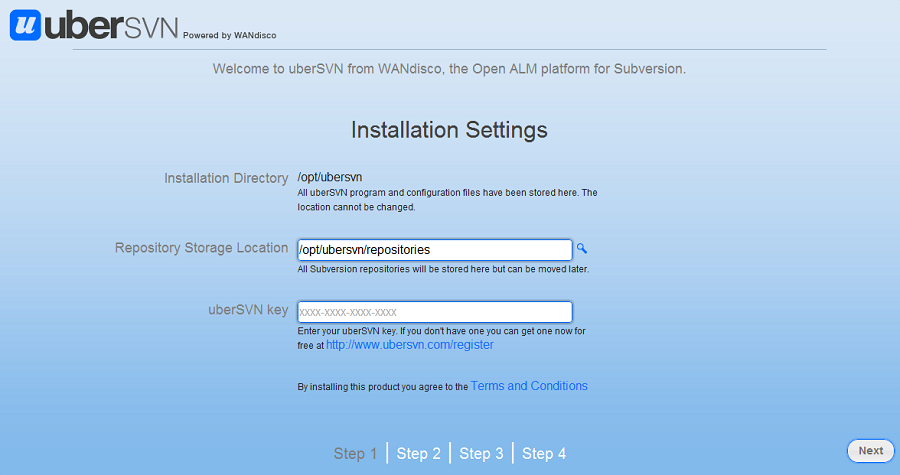
- Installation Directory
- This is the directory in which the uberSVN installation files are saved. Once selected, this can not be changed later. If you need to change the address you will need to reinstall uberSVN.
- Repository Storage Location
- The directory in which all Subversion repositories are stored. This can be modified later.
- uberSVN key
- Enter the uberSVN key. You can get an uberSVN key from the registration section of the uberSVN website - www.ubersvn.com/register
- Terms and Conditions
- By continuing the installation of uberSVN you are confirming that you have agreed to the uberSVN Terms and Conditions.
When all fields have been filled, click Next.
11. Enter the details for the Admin User account.
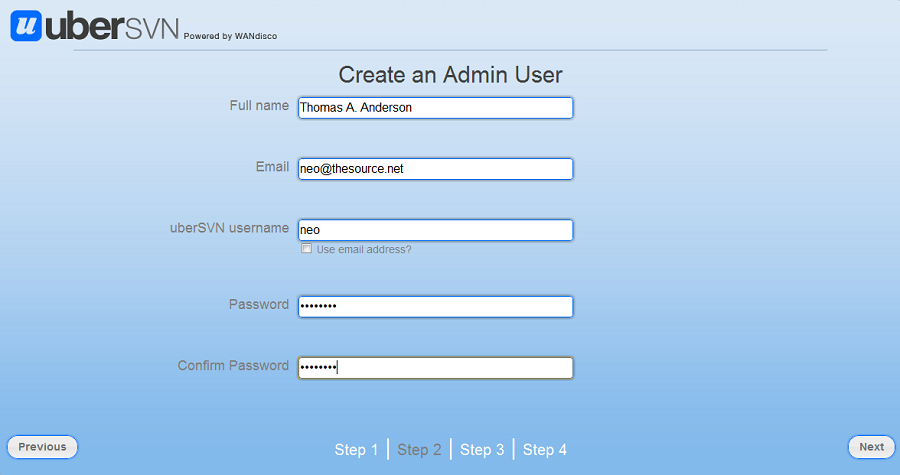
- Full name
- The admin account user's actual name. uberSVN will use this to refer to the admin user.
- Email
- The admin user's email address.
- Password
- The admin user's account password.
- Confirm Password
- Re-enter the password to confirm that you have typed it correctly.
12. Check or change the portal and Apache settings.
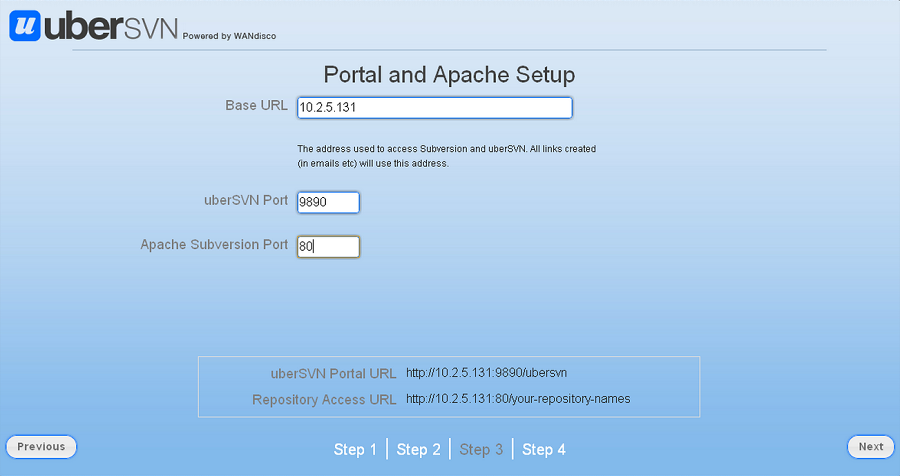
- Base URL
- This is the IP address of the computer on which you are installing uberSVN. You should ensure that this is a global not a private IP, 'localhost' or 127. loopback address (see the box, below) as these will not work for users connecting over a network. The address for remote access to Subversion will be based on this IP address. Need help finding the IP address?
 Caution: Avoid using localhost "127.0.0.1" address as the base URL
Caution: Avoid using localhost "127.0.0.1" address as the base URL
uberSVN will assign the loopback address for the base URL, while this will work fine while the server is being set up and tested it will not work for users who try to connect to uberSVN over a network. We strongly recommend that you replace the "localhost" or "127.0.0.1" address with the server's assigned IP address.

The warning message that will appear if you leave the 127.0.0.1 loopback address in place.
- uberSVN Port
- Port used to access the uberSVN webportal.
 Caution: Avoid using privileged ports.
Caution: Avoid using privileged ports.
uberSVN is set up using ports 9890 for the uberSVN portal and port 9880 for Subversion. These are non-privileged ports that don't need to be executed with root privilege for binding and listening for client requests. You can change the port numbers but you should avoid using common ports (numbered 1023 or lower) as these would make uberSVN a serious potential security hole: a successful exploit will have immediate control of the whole system, compromising it completely.
- Apache Subversion Port
- Port used for accessing the Apache Subversion repositories.
- Example Addresses
- At the bottom of the screen, the uberSVN portal and Repository Access URLs are presented.

These are the URLs that you will use, given the settings that apply if you continue with the chosen settings.
13. Enter the email settings.
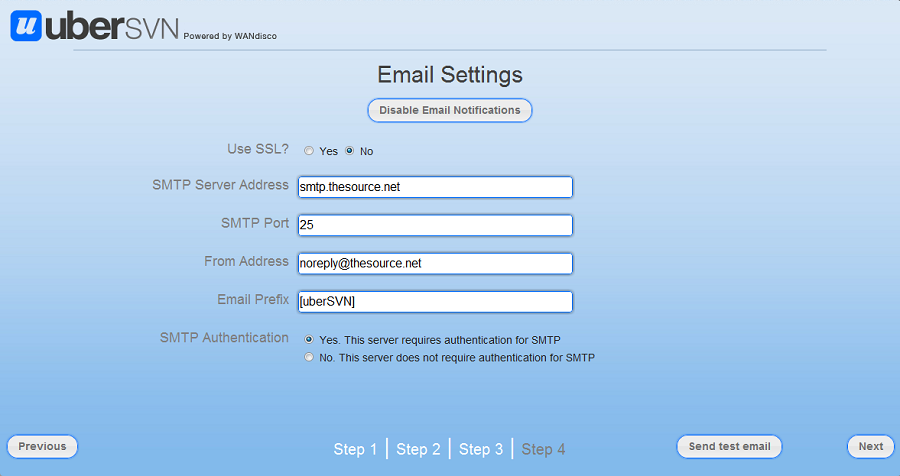
uberSVN will send you emails telling you about about problems, system changes and things you've flagged for triggering alerts.
If email notifications are enabled you'll receive notification emails:
- alerting actions based on user subscriptions (Repository activity, commits etc)
- confirming forgotten Password resets
- admin notifications, including update availability
 uberSVN alert emails come from your server
uberSVN alert emails come from your server
To be clear, these emails are sent from your instance of uberSVN, they are not sent from WANdisco. If receiving yet more emails is going to mess with your calm you can click the Disable Email Notifications button. Just remember that many important system changes or problems will only be reported in log files.
If you don't want uberSVN to support email notifications, or plan to set this up later,
click the Disable Email Notifications
.
- Use SSL?
- Enable secure socket layer encryption for extra email security.
- SMTP Server Address
- The address of your email relays server that will accept emails from uberSVN and send them on to users' emails accounts.
- SMTP Port
- The port used by the above email server to accept emails. The default SMTP port is 25.
- From Address
- Emails sent out by uberSVN will come from this address.
- Email Prefix
- Add a prefix to the notification emails for easier filtering.
 Tip
Tip
If you run multiple instances of uberSVN, use the Email Prefix field to distinguish which instance from which the email has been sent.
- SMTP Authentication
- If the email server requires authentication in order to accept emails, select Yes.
- Send test email
- Click the Send test email to have a test email sent using the above settings.
14. The configuration is now complete. Just click the Start using uberSVN button.
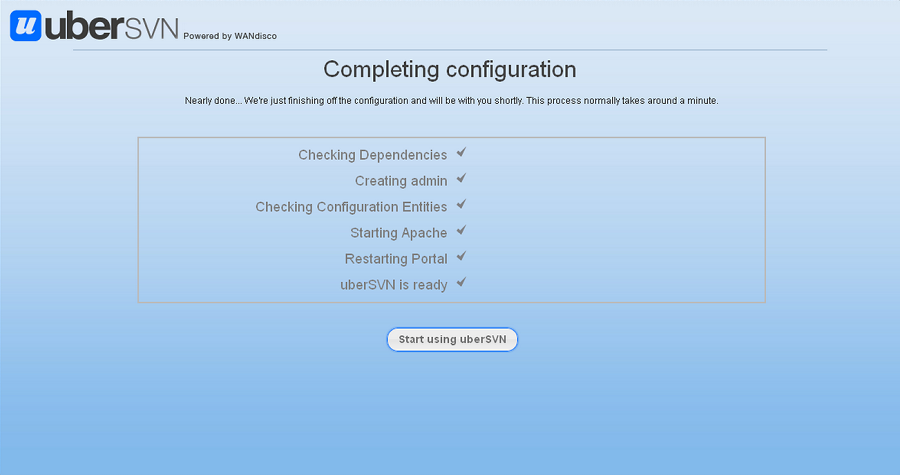 15. The welcome screen will automatically appear. Login using the admin username and password to start using uverSVN.
15. The welcome screen will automatically appear. Login using the admin username and password to start using uverSVN.
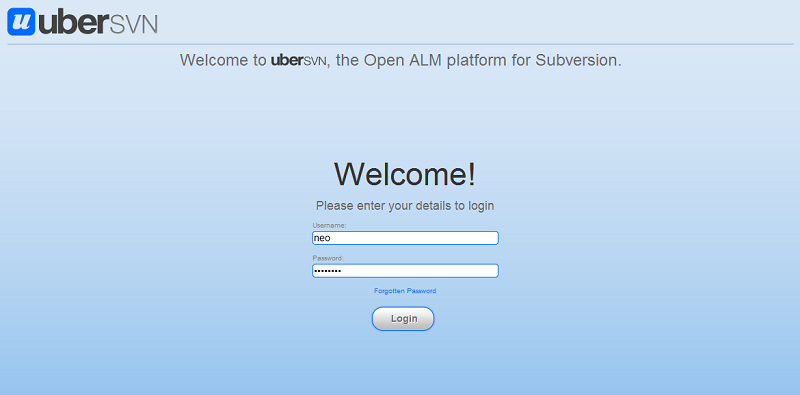
Login to uberSVN using your username and password.
1.3 Windows Installation Guide
Follow this procedure for installing uberSVN on a Windows server.
 Internet Explorer Enhanced Security Configuration
Internet Explorer Enhanced Security Configuration
The Windows Server 2003 and 2008 both ship with Internet Explorer that is locked down with Enhanced Security Configuration. By default Internet Explorer will now allow you to install uberSVN. Read our Knowledgebase article Installing uberSVN with IEESC
4. Click Next.
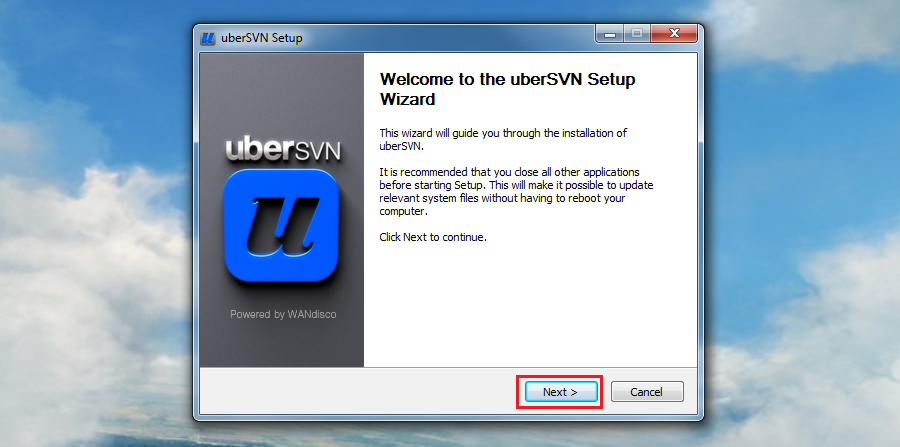
"Next >" to to start the installation.
5. Confirm where you want uberSVN to be installed, then click Install.

Time to Install the uberSVN files.
6. Once all the files have been extracted, click Next >.

"Next >" to complete the installation.
7. Installation will now complete, with uberSVN installed as a Windows service.
There's an option to Start WANdisco uberSVN on boot, tick this to have uberSVN start up automatically whenever the server is started.
Once you're ready to continue the configuration, click the Launch uberSVN now button, or if you want to complete your setup later, click Close. Remember to make a note (or bookmark) the uberSVN URL.
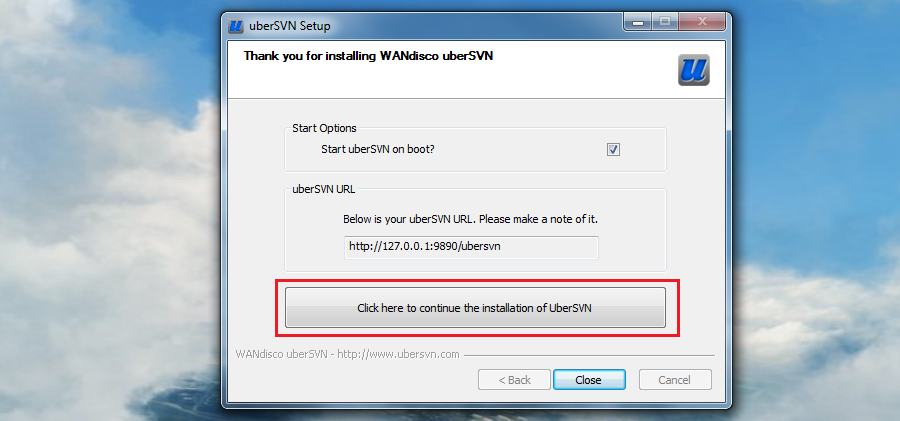
Click the big button, it's time to move on to the final configuration screens.
If you choose not to start uberSVN now you'll need to perform a manual start using the procedure detailed in Starting uberSVN.
 Tip
Tip
If you're installing on a server with limited browser support or restricted display settings, you can complete this next stage from a different computer. All you need to do is open the uberSVN URL in a browser - although you'll need to ensure that you use the server's valid IP address, not the 127.0.0.1 "loopback" address.
8. The first step of the uberSVN web configuration wizard (Installation Settings) will appear. Enter the required details.
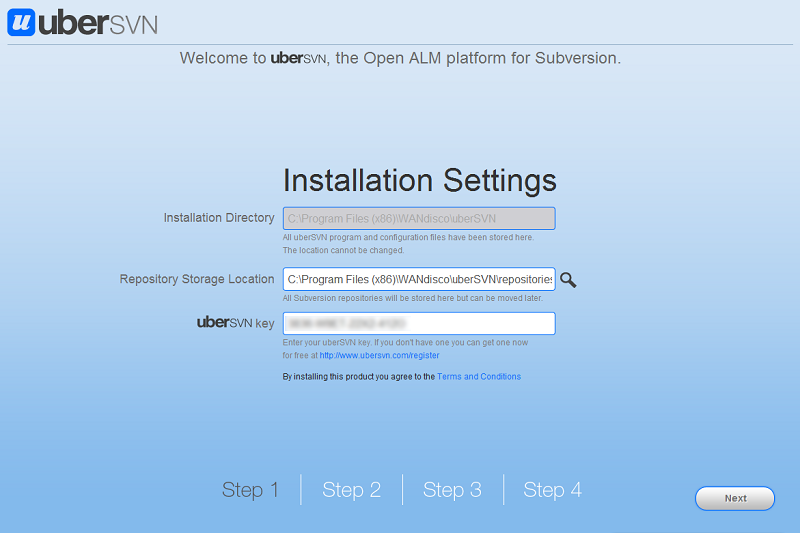
Installation Settings.
- Installation Directory
- This is the directory in which the uberSVN installation files are saved. Once selected, this can not be changed later. If you need to change the address you will need to reinstall uberSVN.
- Repository Storage Location
- The directory in which all Subversion repositories are stored. This can be modified later.
- uberSVN key
- Enter the uberSVN key. You can get an uberSVN key from the registration section of the uberSVN website - www.ubersvn.com/register
- Terms and Conditions
- By continuing the installation of uberSVN you are confirming that you have agreed to the uberSVN Terms and Conditions.
When all fields have been filled, click Next.
9. Enter the details for the Admin User account.
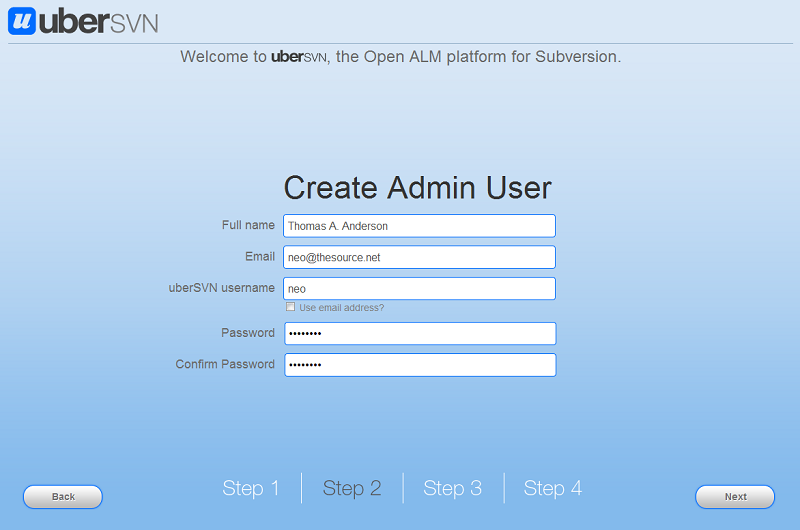
Create an Admin User.
- Full name
- The admin account user's actual name. uberSVN will use this to refer to the admin user.
- Email
- The admin user's email address.
- Password
- The admin user's account password.
- Confirm Password
- Re-enter the password to confirm that you have typed it correctly.
10. Check or change the portal and Apache settings.
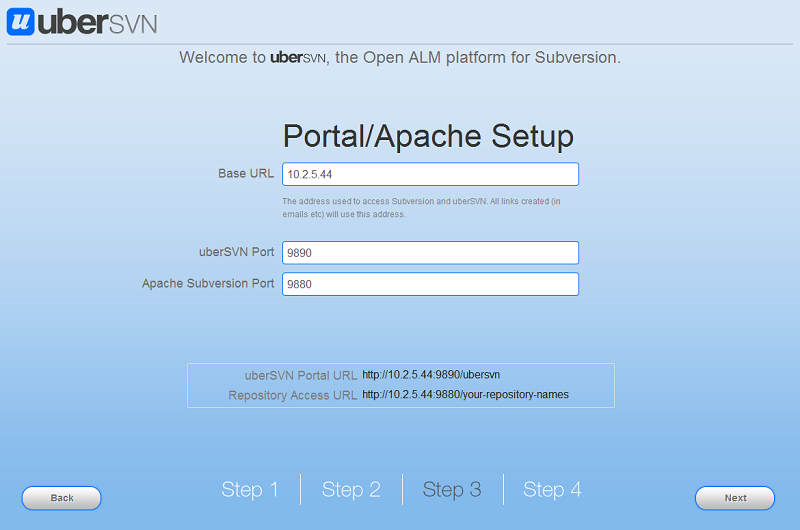
Portal and Apache Setup.
- Base URL
- This is the IP address of the computer on which you are installing uberSVN. You should ensure that this is a global, not a private IP, 'localhost' or '127.' loopback address (see the box, below) as these will not work for users connecting over a network. The address for remote access to Subversion will be based on this IP address. Need help finding the IP address?
 Caution: Avoid using localhost "127.0.0.1" address as the base URL
Caution: Avoid using localhost "127.0.0.1" address as the base URL
uberSVN will assign the loopback address for the base URL, while this will work fine while the server is being set up and tested it will not work for users who try to connect to uberSVN over a network. We strongly recommend that you replace the localhost /127.0.0.1 address with the server's assigned IP address.

The warning message that will appear if you leave the 127.0.0.1 loopback address in place.
- uberSVN Port
- Port used to access the uberSVN portal.
 Caution: Avoid using privileged ports
Caution: Avoid using privileged ports
uberSVN is set up using ports 9890 for the uberSVN portal and port 9880 for Subversion. These are non-privileged ports that don't need to be executed with root privilege for binding and listening for client requests. You can change the port numbers but you should avoid using common ports (numbered 1023 or lower) as these would make uberSVN a serious potential security hole: a successful exploit will have immediate control of the whole system, compromising it completely.
- Apache Subversion Port
-
Port used for accessing the Apache Subversion repositories.
- Example Addresses
- At the bottom of the screen, the uberSVN portal and Repository Access URLs are presented.

Your actual addresses for accessing uberSVN and whatever Subversion repositories you set up.
These are the URLs that you will use, given the settings that apply if you continue with the chosen settings.
11. Enter the email settings.
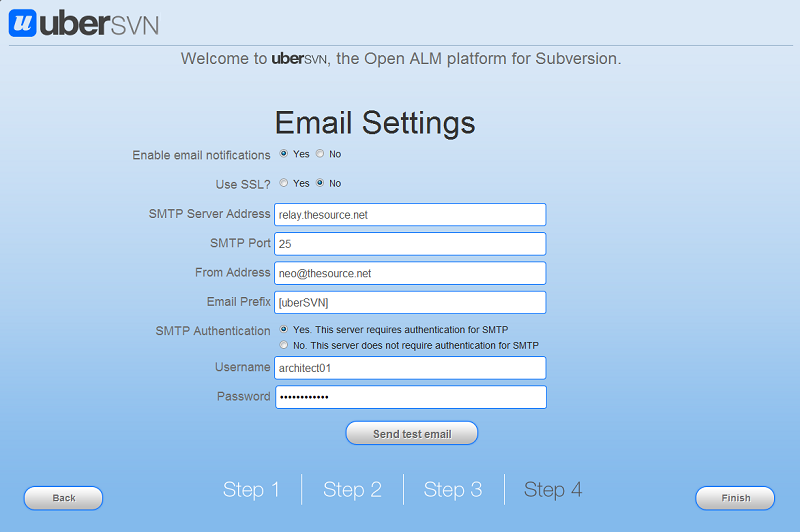
Email Settings. These are optional and can be set up later if required.
uberSVN will send you emails telling you about about problems, system changes and things you've flagged for triggering alerts.
If email notifications are enabled you'll receive notification emails:
- alerting actions based on user subscriptions (Repository activity, commits etc)
- confirming forgotten Password resets
- admin notifications, including update availability
 uberSVN alert emails come from your server
uberSVN alert emails come from your server
To be clear, these emails are sent from your instance of uberSVN, they are not sent from WANdisco. If receiving yet more emails is going to mess with your calm you can click the Disable Email Notifications button. Just remember that many important system changes or problems will only be reported in log files.
If you don't want uberSVN to support email notifications, or plan to set this up later,
click the Disable Email Notifications
.
Email settings are used by uberSVN to send notification emails out to users.
If you don't want uberSVN to support email notifications, or plan to set this up later, click the Disable Email Notifications
.
- Use SSL?
- Enable secure socket layer encryption for extra email security.
- SMTP Server Address
- The address of your email relays server that will accept emails from uberSVN and send them on to users' emails accounts.
- SMTP Port
- The port used by the above email server to accept emails. The default SMTP port is 25.
- From Address
- Emails sent out by uberSVN will come from this address.
These are the URLs that you will use, given the settings that apply if you continue with the chosen settings.
- Email Prefix
- Add a prefix to the notification emails for easier filtering.
 Tip
Tip
If you run multiple instances of uberSVN, use the Email Prefix field to distinguish which instance from which the email has been sent.
- SMTP Authentication
- If the email server requires authentication in order to accept emails, select Yes.
- Send test email
- Click the Send test email to have a test email sent using the above settings.
12. The configuration is now complete. Just click the Start using uberSVN button.
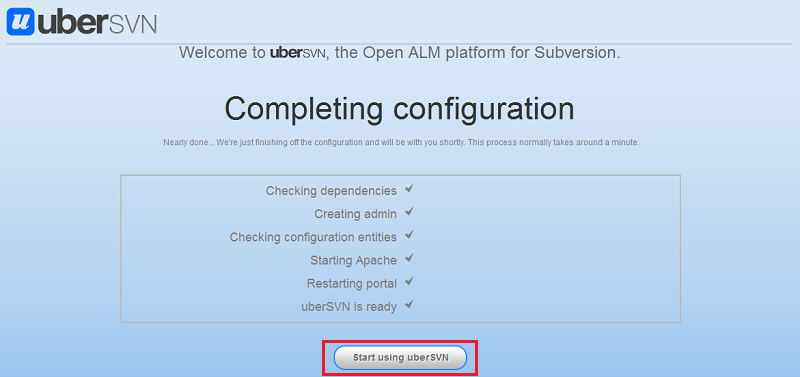
Completing configuration - the final setup screen..
13. The welcome screen will automatically appear. Login using the admin username and password to start using uverSVN.

Login to uberSVN using your username and password.
 It is recommended that you reboot your system as soon as possible after installing uberSVN
It is recommended that you reboot your system as soon as possible after installing uberSVN
The reason for this reboot is to enable a registry change made by uberSVN during the install. This Windows registry change helps with stabilization of the SVN binary switch operation in uberSVN. A reboot does not have to be done immediately, but must happen before an SVN switch operation is attempted through the uberSVN interface.
1.4 Mac OSX Installation Guide
 From MAC OSX Lion, Apple no longer bundle the JRE package
From MAC OSX Lion, Apple no longer bundle the JRE package
If you install uberSVN on the latest versions of OSX you will see this error message:
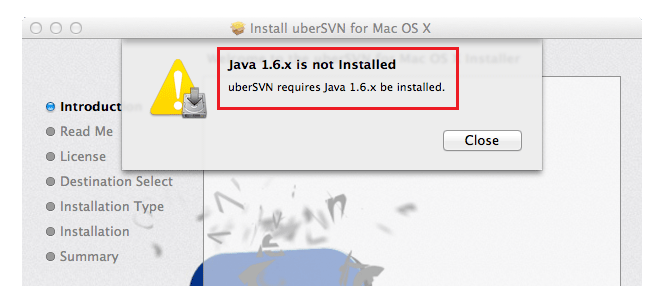
Even if you upgraded to Lion on a machine that already had the JRE package installed, you'll need to install it again.
Installing Java JRE
Follow these steps if you see the Java 1.6.x is not installed error that is shown above. If you already have Java installed continue to Installing uberSVN.
Installing uberSVN
- 1. Get the installation file from the WANdisco website.
- 2. Run the installer.
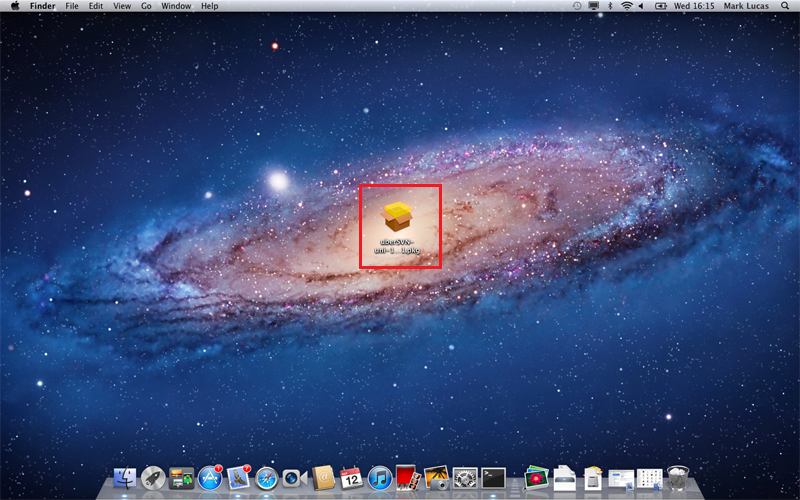
Double click on the installer.
- 3. An introduction screen appears, click Continue.
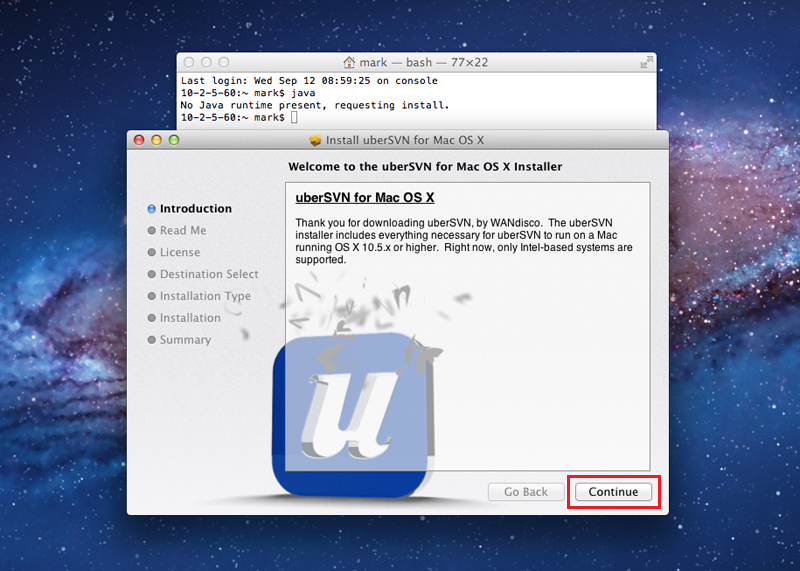
Introduction screen.
- 4. A Read Me screen appears, click Continue.

Read Me provides some extra information.
- 5. Read the Software License Agreement, then click Continue.
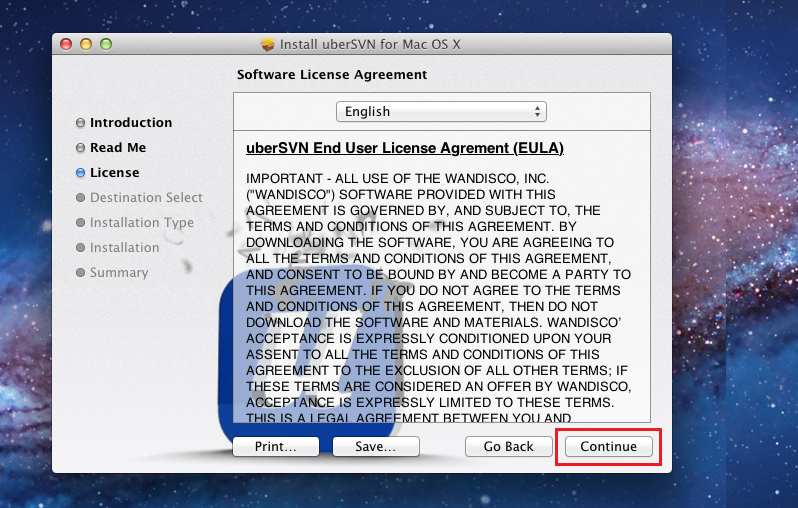
It's dull, but it is important.
- 6. In order to continue the installation you need to confirm that you've agreed with the license agreement, so click Agree.
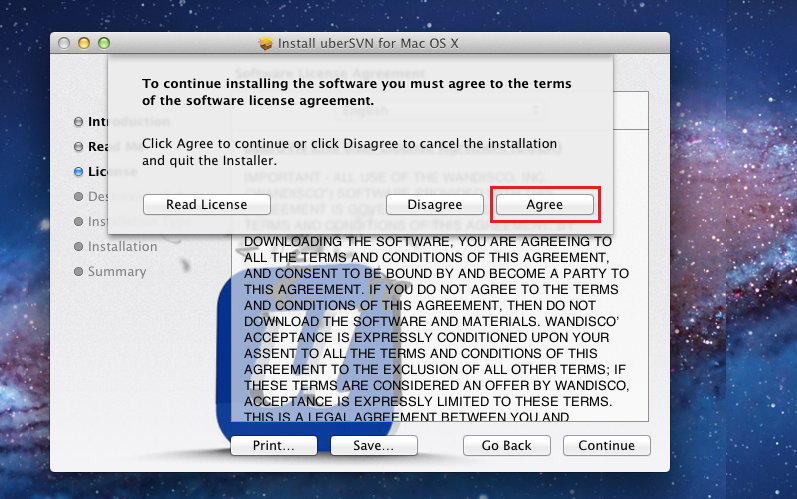
Agree!
- 7. Time to set where uberSVN will be installed.
You'll be told how much disk space will be used by the installation. You'll be forced to Install uberSVN as an administrator, so that the installation will be available for all users on the server. Click Install for all users on this computer and then click Continue. As you're installing new software you'll need to enter your Name and Password.
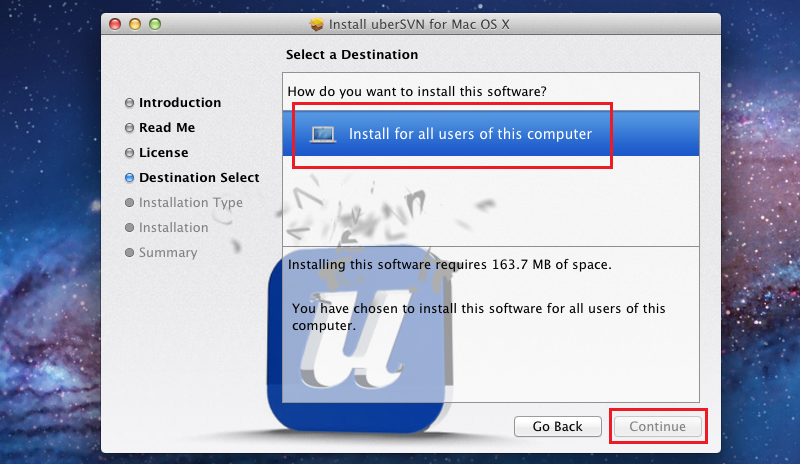
Available for all users
- 8. Installation will now ask you to confirm where to put uberSVN's files.
If you change your mind about the install location, click Change Install Location. Otherwise click Install.
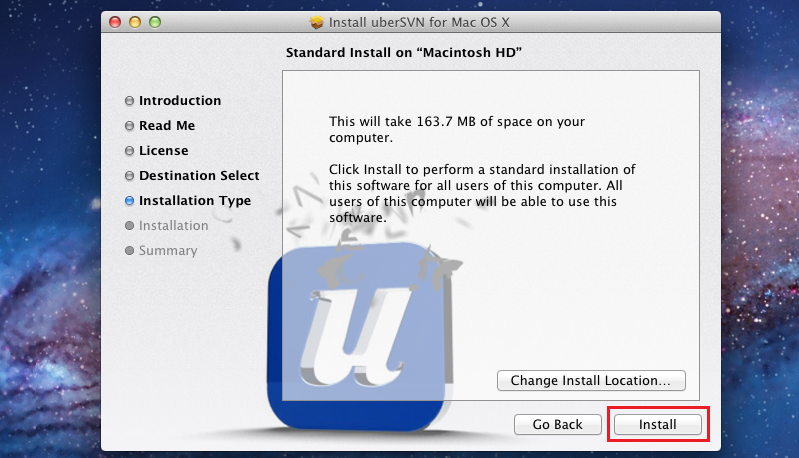
Install time
- 9. uberSVN's files will now be written onto the disk drive.
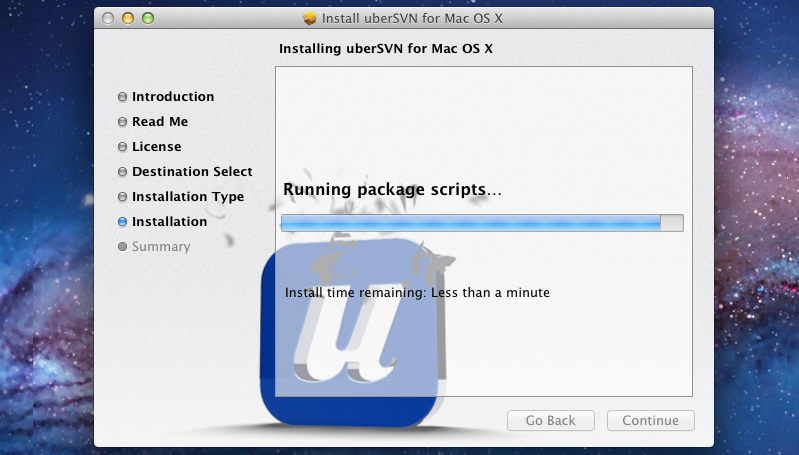
Installation Settings.
When the files finish copying, click Continue.
- 10. The summary screen appears, confirming that uberSVN has now been installed. The next step is completing the setup
which will be done using a web browser. A browser may automatically open, showing the first uberSVN setup screen, if not
click on the provided link. You can now safely close the installer window (click the Close button).
If any problems occur, you may find more information in the error logs which, by default, appear at /opt/ubersvn/data/logs
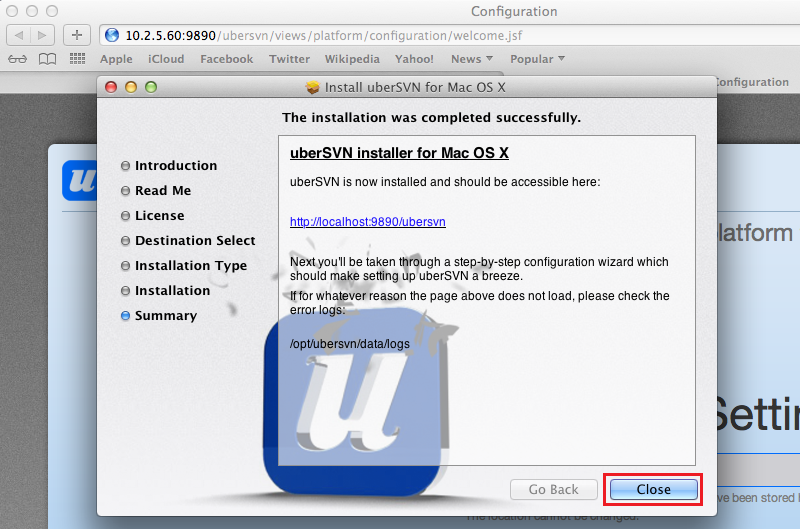
Installation completed! Time to setup uberSVN.
- 11. Step 1 of the setup will confirm where uberSVN and any Subversion repositories will be stored, along with the uberSVN key.
You can confirm your product key by logging into http://www.wandisco.com and click on the Get Key button.
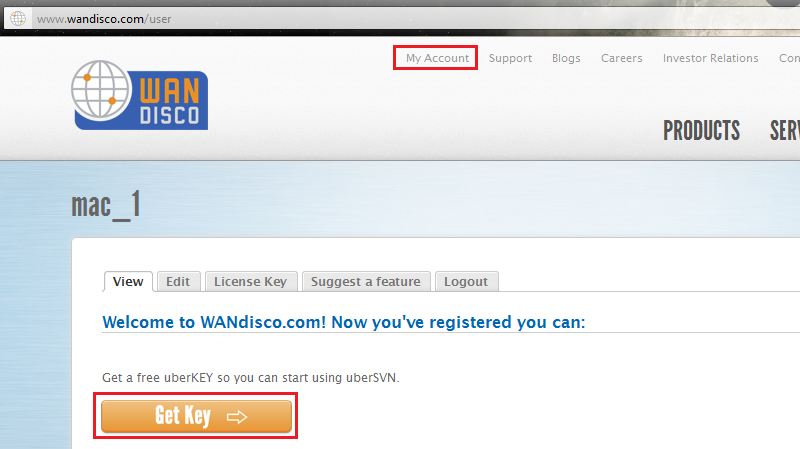
Get key
Enter your uberSVN key into the Step 1 setup screen.

Installation Settings
- 12. Step 2 will confirm the details of the main admin user.
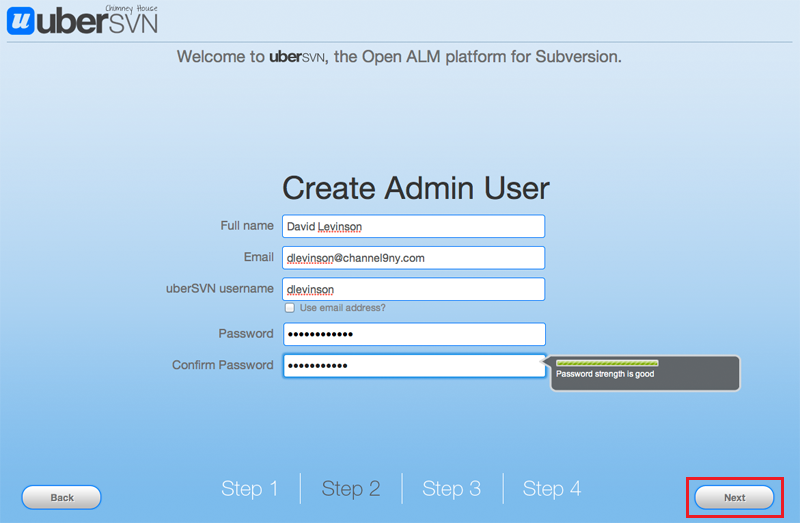
Create an Admin User.
- Full Name:
- The admin user's full name, e.g. David Levinson.
- Email:
- The email address for the user. Tick the Email password to user checkbox to have the password sent to the user in an email.
- uberSVN Username:
- A name by which the admin user will be known on uberSVN. It should consist of a single word, with only numbers and letters.
- Password
- A password, which also should consist of numbers and letters only.
- Confirm Password
- Retype your password, this confirms that you entered your password correctly.
When all details have been entered, click Next to continue the setup.
- 13. Step 3 details the uberSVN's and Apache's addressing.
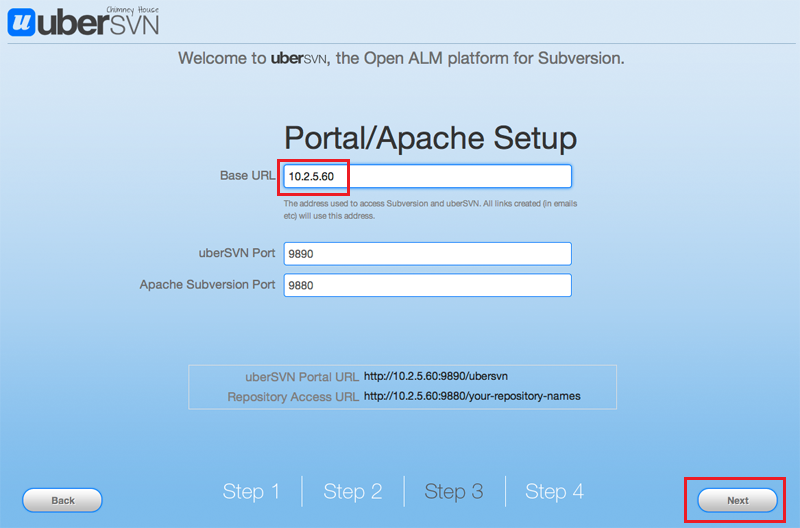
Portal and Apache Setup
- Base URL
- This is the IP address of the computer on which you are installing uberSVN. You should ensure that this is a global, not a private IP, 'localhost' or '127.' loopback address (see the box, below) as these will not work for users connecting over a network. The address for remote access to Subversion will be based on this IP address.Need help finding the IP address?
- uberSVN Port
- Port used to access the uberSVN portal.
 Caution: Avoid using privileged ports
Caution: Avoid using privileged ports
uberSVN is set up using ports 9890 for the uberSVN portal and port 9880 for Subversion. These are non-privileged ports that don't need to be executed with root privilege for binding and listening for client requests. You can change the port numbers but you should avoid using common ports (numbered 1023 or lower) as these would make uberSVN a serious potential security hole: a successful exploit will have immediate control of the whole system, compromising it completely.
- Apache Subversion Port
-
Port used for accessing the Apache Subversion repositories.
- Example Addresses
- At the bottom of the screen, the uberSVN portal and Repository Access URLs are presented.

Your actual addresses for accessing uberSVN and whatever Subversion repositories you set up.
These are the URLs that you will use, given the settings that apply if you continue with the chosen settings.
- 14. Step 4 covers email server settings if you want to use an email server to manage communication between users.
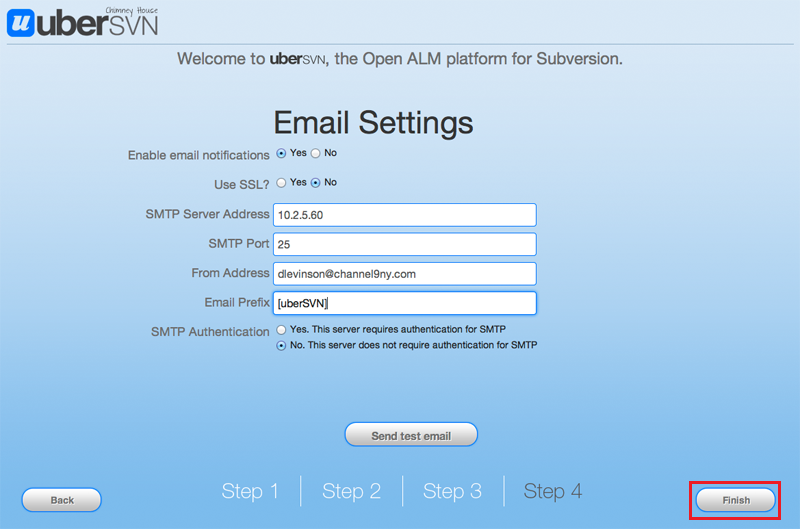
Email Settings. These are optional and can be set up later if required.
Email settings are used by uberSVN to send you emails telling you about about problems, system changes and things you've flagged for triggering alerts.
If email notifications are enabled you'll receive notification emails:
- alerting actions based on user subscriptions (Repository activity, commits etc)
- confirming forgotten Password resets
- admin notifications, including update availability
 uberSVN alert emails come from your server
uberSVN alert emails come from your server
To be clear, these emails are sent from your instance of uberSVN, they are not sent from WANdisco. If receiving yet more emails is going to mess with your calm you can click the Disable Email Notifications button. Just remember that many important system changes or problems will only be reported in log files.
If you don't want uberSVN to support email notifications, or plan to set this up later, click No on the Enable Email Notifcations radio buttons.
- Use SSL?
- Enable secure socket layer encryption for extra email security.
- SMTP Server Address
- The address of your email relays server that will accept emails from uberSVN and send them on to users' emails accounts.
- SMTP Port
- The port used by the above email server to accept emails. The default SMTP port is 25.
- From Address
- Emails sent out by uberSVN will come from this address.
These are the URLs that you will use, given the settings that apply if you continue with the chosen settings.
- Email Prefix
- Add a prefix to the notification emails for easier filtering.
 Tip
Tip
If you run multiple instances of uberSVN, use the Email Prefix field to distinguish which instance from which the email has been sent.
- SMTP Authentication
- If the email server requires authentication in order to accept emails, select Yes.
- Send test email
- Click the Send test email to have a test email sent using the above settings.
- 15. The configuration is now complete. Just click the Start using uberSVN button.
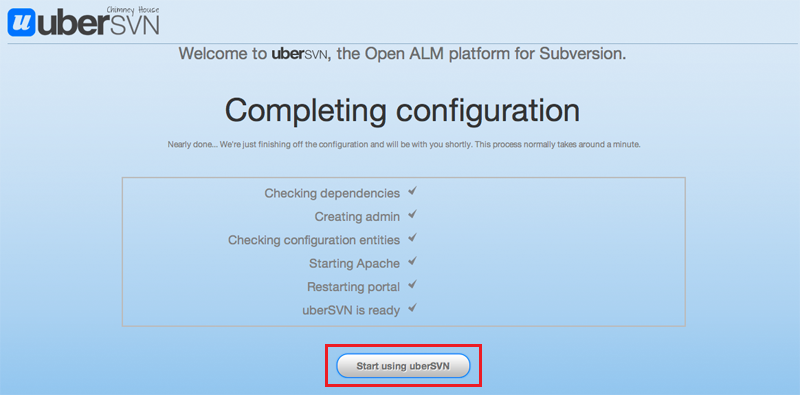
Completing configuration - the final setup screen..
- 15. The welcome screen will automatically appear. Login using the admin username and password to start using uverSVN.
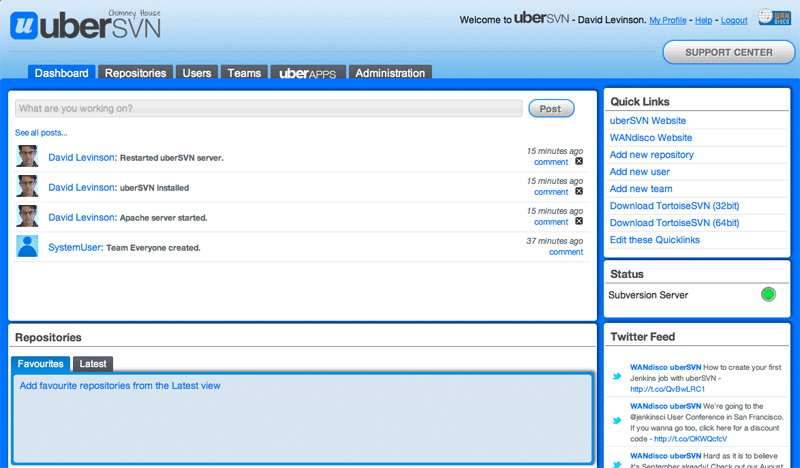
Login to uberSVN using your username and password.
Copyright © 2010-2012 WANdisco plc.
All Rights Reserved
This product is protected by copyright and distributed under
licenses restricting copying, distribution and decompilation.
uberSVN "Chimney House 7"
Last doc build: 16:04 - Thursday 25th October 2012


 Internet Explorer Enhanced Security Configuration
Internet Explorer Enhanced Security Configuration  XP is Not compatible with UberSVN Access Control
XP is Not compatible with UberSVN Access Control Offline installation
Offline installation Caution: Java JRE is no longer included with Mac OS 10.7 Lion onwards)
Caution: Java JRE is no longer included with Mac OS 10.7 Lion onwards) uberSVN is not compatible with Internet Explorer 6
uberSVN is not compatible with Internet Explorer 6 Glassfish compatibility
Glassfish compatibility Error message when running the installer
Error message when running the installer Error message when reinstalling uberSVN on Linux
Error message when reinstalling uberSVN on Linux Caution: Why you should avoid using a port number below 1024.
Caution: Why you should avoid using a port number below 1024.


 Caution: Avoid using localhost "127.0.0.1" address as the base URL
Caution: Avoid using localhost "127.0.0.1" address as the base URL 
 Caution: Avoid using privileged ports.
Caution: Avoid using privileged ports.

 uberSVN alert emails come from your server
uberSVN alert emails come from your server Tip
Tip

 Internet Explorer Enhanced Security Configuration
Internet Explorer Enhanced Security Configuration 
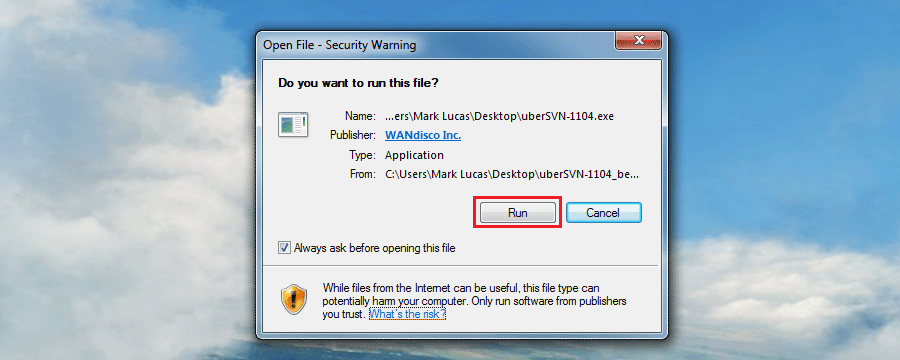




 Tip
Tip


 Caution: Avoid using localhost "127.0.0.1" address as the base URL
Caution: Avoid using localhost "127.0.0.1" address as the base URL 
 Caution: Avoid using privileged ports
Caution: Avoid using privileged ports

 uberSVN alert emails come from your server
uberSVN alert emails come from your server Tip
Tip

 It is recommended that you reboot your system as soon as possible after installing uberSVN
It is recommended that you reboot your system as soon as possible after installing uberSVN From MAC OSX Lion, Apple no longer bundle the JRE package
From MAC OSX Lion, Apple no longer bundle the JRE package
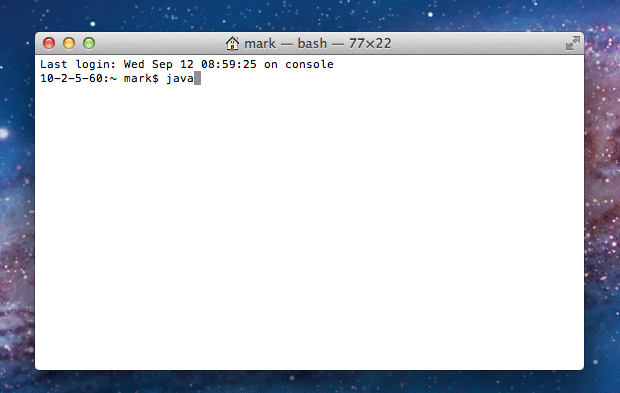
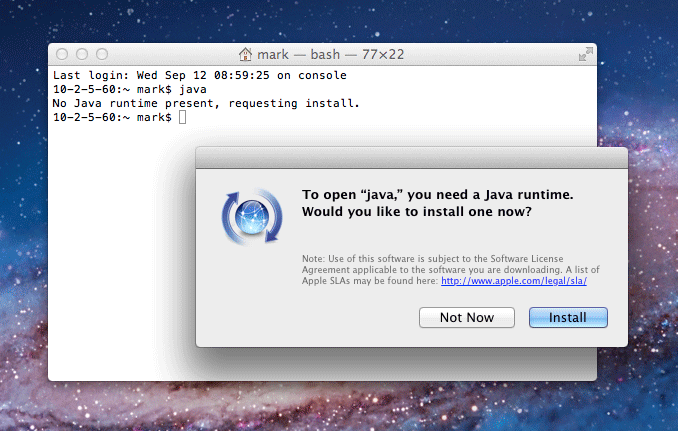














 Caution: Avoid using privileged ports
Caution: Avoid using privileged ports

 uberSVN alert emails come from your server
uberSVN alert emails come from your server Tip
Tip
